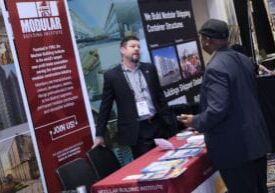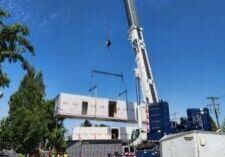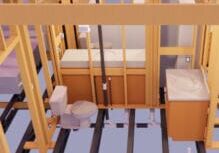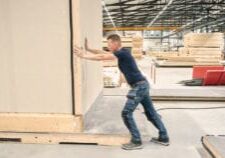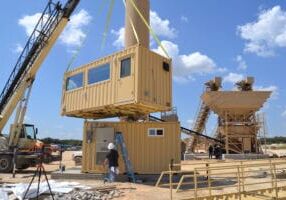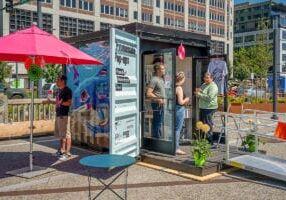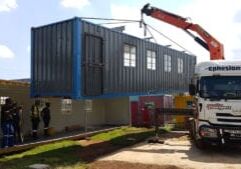America’s Construction Economy: A Race Against Time

Anirban Basu is Chairman & CEO of Sage Policy Group and Chief Economist of the Modular Building Institute.
The Landing is Still Soft
The ongoing strength of the U.S. economy has been a source of incredulity for many economists. When interest rates took off in 2022, a conventional wisdom formed indicating that America was headed for certain recession in 2023. Economists from Bloomberg and elsewhere placed the probability of an economic downturn last year at or near 100 percent. That had everything to do with rising interest rates, which not only caused many stock values to tumble in 2022, but also implied a weakening of both consumer and business spending in 2023.
But no downturn came. Instead, the U.S. economy managed to grow 2.5 percent. Job growth continued, wage pressures persisted, consumers kept spending and travelers kept traveling. Meanwhile, inflationary pressures abated as something akin to pre-pandemic normalcy began to take hold.
While it remains easy to point to many challenges, including in the forms of war, Red Sea piracy, and unpredictable elections transpiring in much of the world, U.S. economic growth has continued apace. According to an initial estimate from the U.S. Bureau of Economic Analysis, the economy expanded at a 2.8 percent annualized rate during 2024’s second quarter. A separate report from the Federal Reserve Bank of Atlanta indicates that the U.S. economy is poised to roughly match that performance during the third quarter.
At the heart of America’s momentum, which has generally not been matched in the balance of the advanced world, has been a consumer who has been willing to ramp up their indebtedness to continue spending. While surging credit card debt and expanding delinquency represent causes for concern, they also reflect an underlying confidence in the future. Much of this confidence is attributable to labor market performances that continue to exceed expectations. An initial estimate from the U.S. Bureau of Labor Statistics indicates that America added another 206,000 in June, which means that national employment is up by 6.3 million since February 2020, the month before the pandemic undid the economy.
While it is true that unemployment has continued to edge higher, standing at 4.1 percent in June, that remains reasonably low by historic standards. A rising unemployment rate is also consistent with diminishing wage pressure, another prominent feature of the U.S. economy. That declining wage pressure along with sharp declines in the price of many goods (though not services) has positioned the Federal Reserve to begin reducing interest rates in September. The prospect of declining interest rates has many economic stakeholders abuzz with hope, something reflected in record stock prices as reflected in many indices like the S&P 500 and Dow Jones Industrial Average.
Home values have also been rising, further expanding American wealth and fueling household expenditures. The Federal Reserve estimates that as of the first quarter 2024, total American household wealth ripped past $151 trillion. To put that into perspective, just four years earlier, household wealth was sitting a bit below $104 trillion. In short, America remains embedded in a virtuous cycle in which household spending helps support growth demand for workers which in turn fuels more spending. Add to the mix massive outlays by tech companies on things like artificial intelligence (AI) platforms and ongoing federal spending on munitions, infrastructure, subsidies to expanding manufacturers, etc., and there remains plenty of aggregate demand powering the economy.
The Ghost of Milton Friedman
If one simply predicted economic outcomes by extrapolating current trends, there would be no reason for concern since the current trend is characterized by forward momentum. But there is this source of disquietude known as economic theory, which was designed by members of the dismal science, and which appears to have as its primary goal the destruction of confidence and certitude wherever and whenever it exists.
Some of these economists are monetarists, who are often among the brightest of the bunch. The godfather of this group is Milton Friedman while the godmother is Anna Schwartz. These brilliant minds liked to point out that monetary policy operates with long and variable lags. If that’s not disquieting, it’s unclear what could be.
What this means is that when interest rates rise, economic impacts do not transpire immediately. Rather, research indicates that it can require 18 months to two years or more for tighter monetary policy to have a material impact on the economy. As it turns out, the Federal Reserve began its rate hiking cycle on March 17, 2022. That was a bit more than two years ago. The reader will note the ominous portent of this insight. Much of the impact of higher interest rates could be in front of us. So, while the economy has been engaging in a soft landing, the ultimate landing may not be so soft.
Already, one can hear the rumblings of a less vibrant economy. For instance, the number of construction job openings fell sharply during a recent month as the number of construction starts declines. In June, industry job openings dipped by 71,000 to 295,000. Indeed, the pace of hiring among employers across all industries recently declined to multiyear lows. Leading indicators like residential building permits and fading architectural billings also hint at falling demand for construction services. The Associated Builders and Contractors Construction Backlog Indicator is 0.5 months lower than it was a year ago, sitting at 8.4 months. While the Federal Reserve will likely chip away at high interest rates during the months ahead, those rates will remain above rates to which economic actors had become accustomed, whether prospective homebuyers or owners of increasingly vacant office buildings.
In June, the latest month for which nonresidential construction data are available from the U.S. Census Bureau, nonresidential construction spending declined 0.2 percent not adjusting for inflation. Private construction spending declined 0.1 percent, an indication that those elevated interest rates have begun to take more of a bite out of industry momentum.
Looking Ahead
It would be easy to dismiss ramblings regarding an economic slowdown. After all, economists have been talking about such things for more than two years, and yet the economy has generally flourished. Many can and will also take comfort in upcoming interest rate reductions. The associated reason for optimism is obvious. If the economy has been able to handle higher interest rates thus far, undoubtedly it will be able to manage the lower interest rates to come. But many economists are pointing out that the Federal Reserve may already be too late to the game. While they gradually reduce interest rates, the U.S. economy could quickly decelerate, at least based on theoretical grounds if not on the most recent data releases, culminating in that long-predicted recession. Only time will tell.
More from Modular Advantage
AI, Faster Sets, and Automation: The Future of Modular is at World of Modular
While the modular building industry has long known that it can be an effective solution to increase affordable housing, the word is slowly spreading to more mainstream audiences. Three presentations at this year’s World of Modular in Las Vegas hope to provide insight and direction for those seeking a real solution to the crisis.
An Insider’s Guide to the 2025 World of Modular
The Modular Building Institute is bringing its global World of Modular (WOM) event back to Las Vegas, and with it comes some of the industry’s best opportunities for networking, business development, and education. Over the course of the conference’s four days, there will be numerous opportunities for attendees to connect, learn, and leverage event resources to get the most out of the conference.
Affordable Housing Now: The Industry’s Best Bring New Solutions to World of Modular
While the modular building industry has long known that it can be an effective solution to increase affordable housing, the word is slowly spreading to more mainstream audiences. Three presentations at this year’s World of Modular in Las Vegas hope to provide insight and direction for those seeking a real solution to the crisis.
Opportunities for Innovation in Modular Offsite Construction
Modular Offsite Construction has already shattered the myth that it only produces uninspired, box-like designs. Architectural innovations in module geometry, configurations, materials, and products make it possible to create visually stunning buildings without sacrificing functionality or efficiency.
Safe Modular Construction with Aerofilm Air Caster Transport
In collaboration with Aerofilm Systems, Heijmans developed innovative skids using air caster technology for moving modules easily and safely. These pallets are equipped with an auto-flow system, making operation extremely simple.
Miles, Modules, and Memes: Building a Modular Network One Flight at a Time
At the end of the day, social media is just another tool for building connections, and like any other tool, needs to be used skillfully to work properly. Use social media thoughtfully, and it will open doors to real opportunities and relationships you didn’t even see coming.
Falcon Structures: Thinking Inside the Box
Some of Falcon’s latest projects include creating container solutions for New York’s Central Park and an East Coast professional baseball team. More and more, Falcon is shipping out container bathrooms and locker rooms to improve traditionally difficult work environments, like those in oil and gas or construction.
UrbanBloc—From Passion to Industry Leader
UrbanBloc specializes in three main categories or markets – what they call “Phase 0” projects, amenities, and urban infill. Clients are often attracted to shipping containers because from a real estate perspective they are considered an asset. Having the flexibility to move and transport these assets allows owners to respond to different circumstances in a fluid manner that they can’t get with standard construction.
The Hospitality Game-Changer
“Hospitality is about more than just providing a service – it’s about delivering an experience,” says Anthony Halsch, CEO of ROXBOX. “And that’s where containers thrive. They allow us to create spaces that are unique, efficient, and sustainable.”
Container Conversions Counts on Simplicity to Provide Critical Solutions
Container Conversions has fabricated and developed thousands of containers for varied projects, including rental refrigeration options, offices, kitchens, temporary workplace housing, and mobile health clinics.


